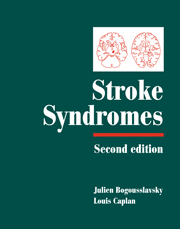Book contents
- Frontmatter
- Contents
- List of contributors
- Preface
- PART I CLINICAL MANIFESTATIONS
- PART II VASCULAR TOPOGRAPHIC SYNDROMES
- 29 Arterial territories of human brain
- 30 Superficial middle cerebral artery syndromes
- 31 Lenticulostriate arteries
- 32 Anterior cerebral artery
- 33 Anterior choroidal artery territory infarcts
- 34 Thalamic infarcts and hemorrhages
- 35 Caudate infarcts and hemorrhages
- 36 Posterior cerebral artery
- 37 Large and panhemispheric infarcts
- 38 Multiple, multilevel and bihemispheric infarcts
- 39 Midbrain infarcts
- 40 Pontine infarcts and hemorrhages
- 41 Medullary infarcts and hemorrhages
- 42 Cerebellar stroke syndromes
- 43 Extended infarcts in the posterior circulation (brainstem/cerebellum)
- 44 Border zone infarcts
- 45 Classical lacunar syndromes
- 46 Putaminal hemorrhages
- 47 Lobar hemorrhages
- 48 Intraventricular hemorrhages
- 49 Subarachnoid hemorrhage syndromes
- 50 Brain venous thrombosis syndromes
- 51 Carotid occlusion syndromes
- 52 Cervical artery dissection syndromes
- 53 Syndromes related to large artery thromboembolism within the vertebrobasilar system
- 54 Spinal stroke syndromes
- Index
- Plate section
51 - Carotid occlusion syndromes
from PART II - VASCULAR TOPOGRAPHIC SYNDROMES
Published online by Cambridge University Press: 17 May 2010
- Frontmatter
- Contents
- List of contributors
- Preface
- PART I CLINICAL MANIFESTATIONS
- PART II VASCULAR TOPOGRAPHIC SYNDROMES
- 29 Arterial territories of human brain
- 30 Superficial middle cerebral artery syndromes
- 31 Lenticulostriate arteries
- 32 Anterior cerebral artery
- 33 Anterior choroidal artery territory infarcts
- 34 Thalamic infarcts and hemorrhages
- 35 Caudate infarcts and hemorrhages
- 36 Posterior cerebral artery
- 37 Large and panhemispheric infarcts
- 38 Multiple, multilevel and bihemispheric infarcts
- 39 Midbrain infarcts
- 40 Pontine infarcts and hemorrhages
- 41 Medullary infarcts and hemorrhages
- 42 Cerebellar stroke syndromes
- 43 Extended infarcts in the posterior circulation (brainstem/cerebellum)
- 44 Border zone infarcts
- 45 Classical lacunar syndromes
- 46 Putaminal hemorrhages
- 47 Lobar hemorrhages
- 48 Intraventricular hemorrhages
- 49 Subarachnoid hemorrhage syndromes
- 50 Brain venous thrombosis syndromes
- 51 Carotid occlusion syndromes
- 52 Cervical artery dissection syndromes
- 53 Syndromes related to large artery thromboembolism within the vertebrobasilar system
- 54 Spinal stroke syndromes
- Index
- Plate section
Summary
Pathophysiology of carotid ischemic Syndromes
Occlusion of the internal carotid artery (ICA) remains frequently asymptomatic, especially concerning progression of high grade carotid stenosis to total blockage which left enough time for the progressive development of collateral pathways (Rautenberg et al., 1990). In other cases, ICA occlusions lead either to territorial infarctions related to embolic occlusions of the main intracranial arteries, particularly of the middle cerebral artery and its branches or to hemodynamically induced extraterritorial infarctions. Pial artery occlusions resulting from embolism induce more severe neurological deficits and have a worse neurological prognosis. By contrast, hemodynamically induced infarctions most often lead to repetitive minor strokes and fluctuating symptoms. Different patterns of brain lesion can be observed: (i) pial artery territory infarction or, less frequently, lenticular infarction suggestive of an embolic mechanism; (ii) subcortical terminal supply area infarction or cortico-subcortical watershed infarctions suggestive of an hemodynamically induced infarction (Ringelstein et al., 1983).
The bettter the collateral circulation (circle of Willis, leptomeningeal anastomoses, ophthalmic artery, cervical anastomosis between ipsilateral segmental ICA occlusion, above the stump, and a branch of the external carotid artery (ECA) (occipital artery (Bowen et al., 1997) or the ascending pharyngeal artery (Brückman et al., 1987)), the smaller the volume of cerebral infarction and the better the stroke outcome (Takagi & Shinoara, 1981; Hedera et al., 1995).
Embolic mechanism
The predominantly embolic nature of strokes following ICA occlusion has been described by several authors. However, embolus may fire into the MCA just before the definite occlusion of a severe stenotic or ‘nearly occluded’ carotid artery (Kniemeyer et al., 1996).
- Type
- Chapter
- Information
- Stroke Syndromes , pp. 651 - 659Publisher: Cambridge University PressPrint publication year: 2001



